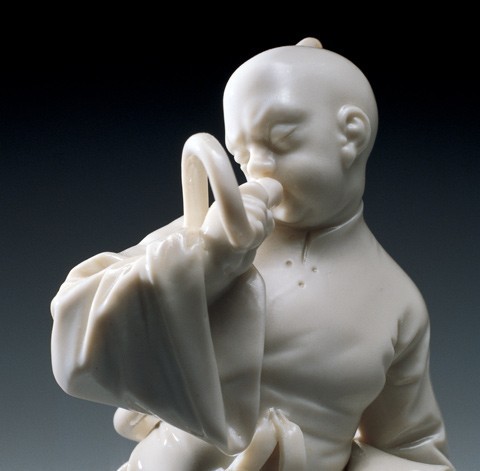
Franz Anton Bustelli, detail view of a Chinese musician figure, Nymphenburg, Germany, twentieth century after a ca. 1750 original from the Nymphenburg factory. Porcelain. H. 4 15/16". (Hood Collection; photos by Gavin Ashworth unless otherwise noted.)

Side view of the figure illustrated in fig. 1.
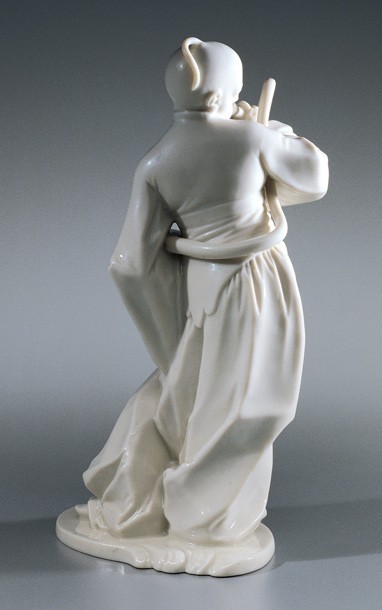
Back view of the figure illustrated in fig. 1.
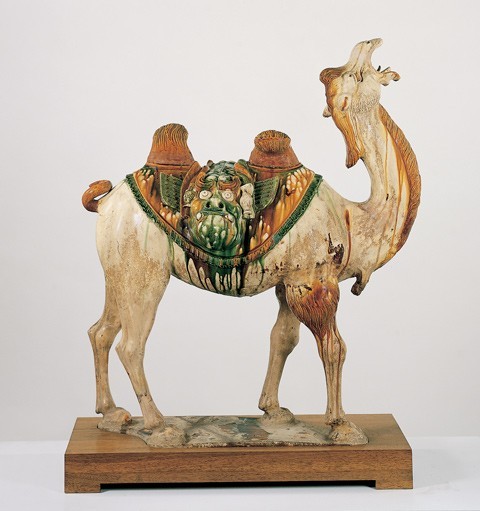
Sepulchral figure of a Bactrian camel, China, T’ang period, eighth century. Glazed earthenware. H. 34 1/2". (Courtesy, Wadsworth Atheneum Museum of Art, Hartford, gift of James Junius Goodwin.)

Fruit basket, American China Manufactory (Bonnin and Morris), Philadelphia, 1770–1772. Soft-paste porcelain. D. 6 7/8". (Courtesy, Detroit Institute of Arts, Founders Society Purchase, Gibbs-Williams Fund; photo © 2002.)

Majolica fragments, Italy, fifteenth century. Tin-glazed earthenware. (Courtesy, Detroit Institute of Arts, gift of Dr. Wilhelm R. Valentiner; photo © 1975.)
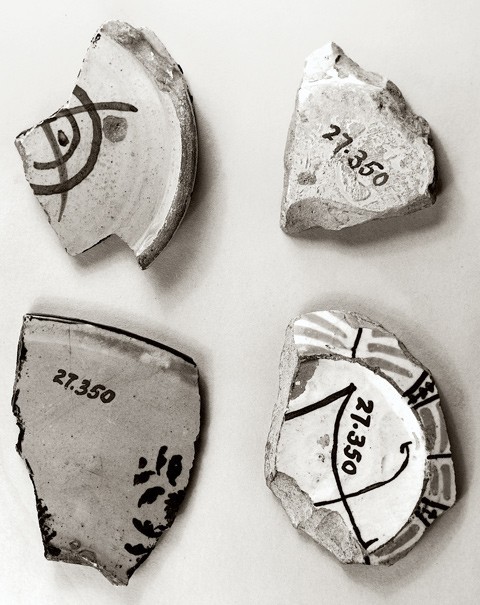
Back view of the majolica fragments illustrated in fig. 6.
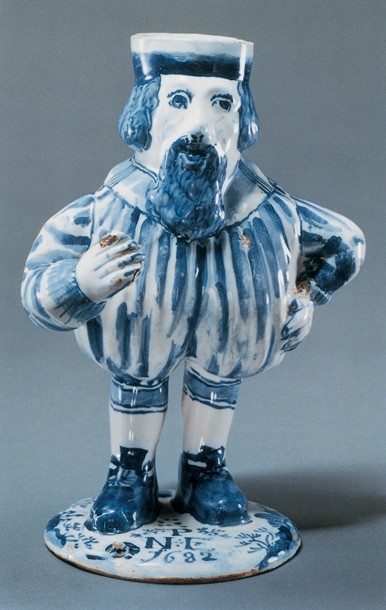
“Mr. Nobody,” London, 1682. Tin-glazed earthenware. H. 8 1/2". (Courtesy, Colonial Williamsburg Foundation.)
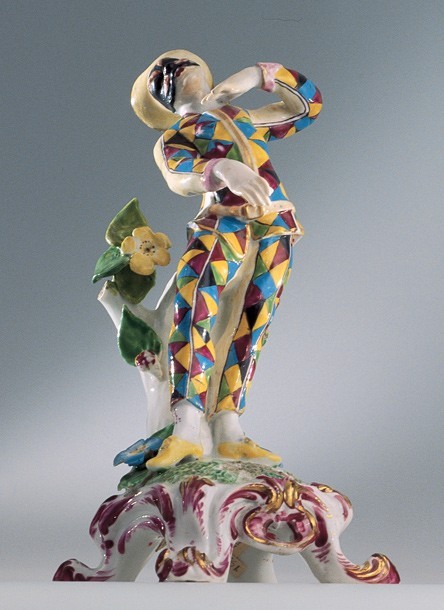
Harlequin figure, Bow Porcelain Factory, London, ca. 1760. Soft-paste porcelain. H. 7 3/4". (Courtesy, Colonial Williamsburg Foundation.)
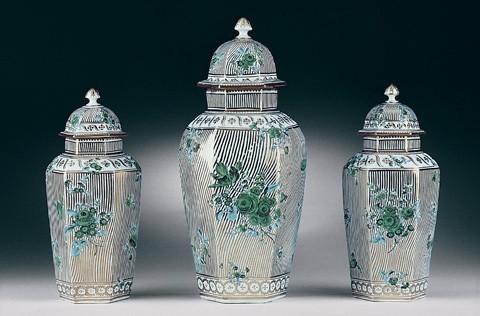
Garniture, Worcester Porcelain Manufactory, Worcester, ca. 1770. Soft-paste porcelain. H. of tallest: 15 3/8". (Courtesy, Colonial Williamsburg Foundation.)
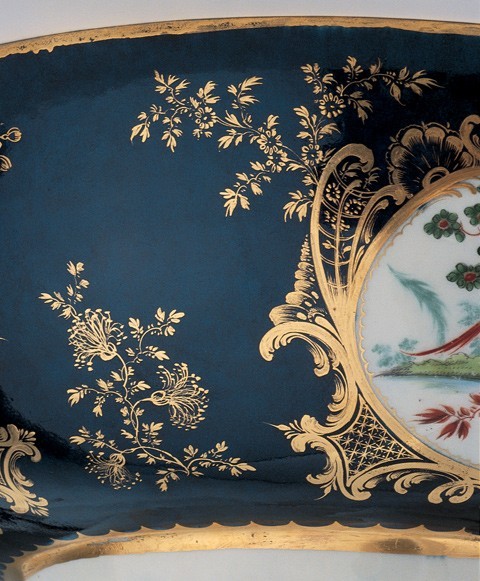
Detail of bowl, Worcester Porcelain Manufactory, Worcester, ca. 1770. Soft-paste porcelain. D. 11." (Courtesy, Colonial Williamsburg Foundation.)
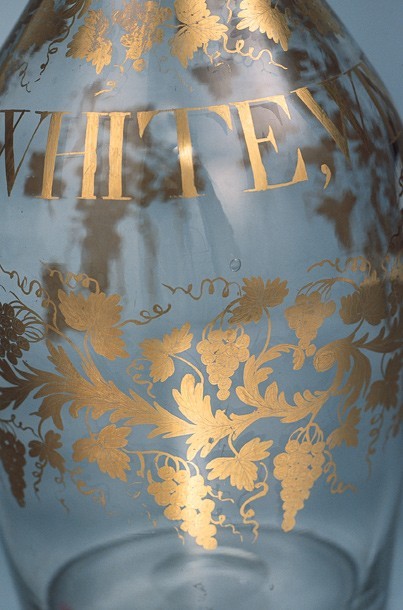
Detail of one of a pair of gilt decorated lead glass decanters, England, ca. 1770. H. 11 3/4". (Courtesy, Colonial Williamsburg Foundation.)
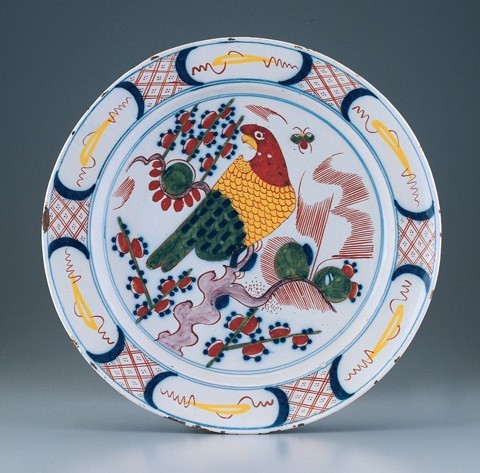
Dish, Netherlands, 1720–1740. Tin-glazed earthenware. D. 13 1/2". (Hood Collection.)

Tile, Netherlands, ca. 1700. Tin-glazed earthenware. W. 5 1/8". (Hood Collection.)
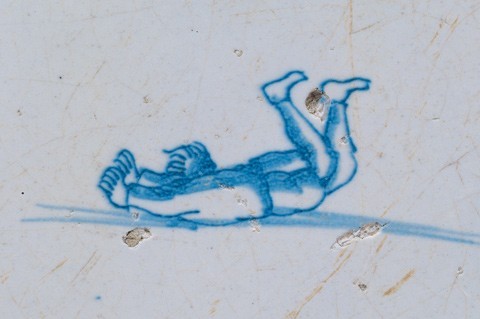
Detail of the tile illustrated in fig. 14.

Étienne-Maurice Falconet, Trump, Chelsea, 1745–1750. Soft-paste porcelain. L. 11 1/2". (Courtesy, Colonial Williamsburg Foundation.)
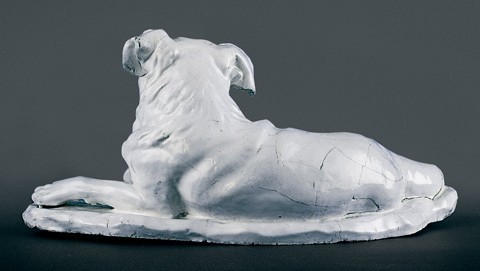
Back view of Trump, illustrated in fig. 16.

Anthony Baecher, seated goat figure, Winchester, Virginia, ca. 1880. Lead-glazed earthenware. H. 6 7/8". (Courtesy, American Folk Art Museum, promised gift of Ralph Esmarian; photo, John Bigelow Taylor © 2000).

Michelle Erickson, seated goat after Anthony Baecher, 1995. Glazed earthenware. H. 6 7/8". (Hood Collection.)

Detail of the Chinese musician illustrated in fig. 1.
Over forty years ago I took up my first curatorial post, assuming responsibility for a wide-ranging collection of European decorative arts. It included notable groups of eighteenth-century Meissen figures and fine French porcelains from the J. P. Morgan Collection, early English porcelains, as well as Chinese ceramics from the sixth century onward. I have to admit that my knowledge and experience of such objects then, without putting too fine a point on it, was absolutely nil. They constituted a branch of art history and collecting history of which I was wholly ignorant.
Although my parents were born, as was I, on the edge of “The Potteries” in England, I recall nothing of the far-flung and beneficent influence of that region on our breakfast, dinner, or tea tables. No fond light did I ever see come into my parents’ eyes, no faint smile of proud possession relax their lips when they handled teapot or platter. Even as I matured, through three years of history at Oxford and two years of art history at the Courtauld Institute in London, I cannot recall “porcelain” ever being mentioned as a subject worthy of attention.
So it is a matter of some retrospective surprise that I have found these things, of such little consequence in my background and in the estimate of serious historians and art historians of that time, so intriguing, charming, beautiful. What follows is a personal testament to the power of ceramics to arouse the deepest feelings of delight and of curiosity—their fragile loveliness capable of producing the same kind of awe as a beautiful bird’s wing, their durable constituents able suddenly to bring to life a moment of civilization, of human beings’ aspirations and needs, long gone.
This essay is also a paean, in part, to the power and importance of “aesthetic incest,” as scornfully defined by Walter Muir Whitehill in the 1960s. An influential historian of his day, Whitehill wrote that “no amount of the aesthetic incest of sitting and gazing at a chair, or a pot, will tell one anything of value about the object, beyond its existence.” I strongly disagreed then, and I still do. But more than that, I suppose I have felt sorry for people like him who could not derive deep spiritual nourishment from something of great beauty. There is a well-known ode by the English Romantic poet John Keats addressed to a Grecian urn that contains some immortal and oft-quoted lines. One, rarely quoted, is as follows: “Thou, silent form, dost tease us out of thought / As doth eternity.” Whether it be a classical urn of great purity of line and complexity of decoration, or a rococo figurine that is amazingly evocative of human beauty, gazing at a pot can be as profoundly moving and restorative as, I believe, prayer can be.[1]
As a curator in charge of more than two hundred of his creations, my discovering the nature of German sculptor Johann Joachim Kaendler’s genius was akin to the way it must have been to meet his little figures on an eighteenth-century dessert table for the first time. Sir Charles Hanbury-Williams expressed it most happily in 1749: “When the Desert was set on, I thought it was the most wonderful thing I ever beheld. I fancy’d myself either in a Garden or at the Opera.” Like Sir Charles I have been able to enter into the garden or walk about on the stage. As a curator I have been able to pick the figures up, turn them around at will, and examine them from every angle. Some of them are grave, others are frankly pictorial, some have an intended German pompousness, while others, especially the commedia dell’arte figures, are so full of animation, their gestures so large, their dress so distinctive, that they invariably evoke a warm smile. The best of them do not seem small. As you focus and gaze on them intently, they grow in size; they are no longer decorative whimsies or baubles, they are sculpture.[2]
During this period of discovery I shared an office with a fellow curator, who had started his first museum job the very same day as I. He was in charge of paintings and sculpture and was passionate about contemporary art. Yet he had unusually wide-ranging taste and a most perceptive eye. He also registered the same delight at these little figures that I did. We visited other collections, especially the Metropolitan Museum’s expansive holdings of similar objects. In doing so, I became aware of the work of Franz Anton Bustelli of Nymphenburg and admired his great playfulness. His figures, I thought, without analyzing it at length then, were more expressive and more sharply modeled than Kaendler’s. They seemed to me to represent the next stage of development in the art.[3]
One day my colleague told me he had been looking at examples of Bustelli’s work and had been particularly moved by some all-white Chinese figures. He spoke of them with great animation and genuine admiration. I went to see them as soon as possible. I was spellbound by these Chinese musicians. My colleague had noted how the modeler appeared to have crafted the costumes with unusual speed and breathtaking sureness, taking off broad slices of clay with a knife and creating an extraordinary and most vivid sense of movement, a sense only enhanced by their pure whiteness. They were a revelation to me.
A couple of years later, through the kind agency of another colleague, I became the proud possessor of a facsimile of one of these Chinese figures. It had been made at the Nymphenburg factory, using (it was claimed) the same clay and molds that Bustelli had used in the late 1750s (figs. 1-3). I have looked at and held this little treasure thousands of times and still marvel at how so small a thing can be so expressive. In the perfection of its replication it continues to suggest the essence of the ineffable grace of a superb musical phrase.[4]
The small form also has a delicious fluidity of movement in the languid turns and twists of its body. But I had never articulated to myself this aspect of its genius quite so well as the art historians, John Fleming and Hugh Honour, in a phrase written long ago, but which I have discovered only recently: “[Bustelli’s figures] are represented in attitudes which could not physically be held for more than a split second, caught in movement at the moment of supreme grace. No sculptor and, indeed, no medium less delicate than porcelain, has ever succeeded in catching the fleeting movements of the human figure with greater sensitivity.”[5] To which I can only add that the more I have gazed at this piece over the years, the more poignant its allusions to the fleetingness of human grace have become.
While discovering the pleasures of early Meissen at my museum, I was also coming to appreciate the beautiful elegance of form and refinement of color of Vincennes and early Sevres porcelains, and the incomparable whiteness of St. Cloud. At the same time, I was most fortunate to be introduced to oriental ceramics (as they used to be called). Another of my colleagues had lived in Korea for some years, and he played a key role in this joyful development. A gruff New Englander, he placed these wares on a pedestal of purity and restraint that seemed unequaled, though he would not have said so in as many words. His discovery of them had been intuitive and by practical experience. As a result of what I picked up from him, I spent as much time as possible in the oriental galleries of major museums, and had my aesthetic awareness of the wondrous subtleties of form and color expanded and enriched beyond anything I could have imagined. An hour of quietude in a museum in Boston, New York, or Philadelphia nourished me spiritually for months.[6]
I was to discover, however, that not all oriental ceramics are the essence of restraint and purity. In my recollection of American museums of forty years ago, it seems that most T’ang figures on display were small and rather statuesque, so it was with astonishment that one day I came upon a figure almost three feet high, almost as long, and of tremendous expressiveness and power (fig. 4). It was a Bactrian camel, in the familiar green, brown, yellow, and cream T’ang colors. On its back was a large cloth over which hung a highly ornate warrior’s saddlebag, modeled with great detail. The colors cascaded down from the cloth and bag under the animal’s belly, from its shoulders down the front legs, and from the head and forelock down the arched neck. They gave the impression that the animal was enduring enormous stress—they might almost have been blood—a sense only accentuated by the upward and sideways lift of the creature’s head, the mouth wide open as if in a huge scream.
Monumental T’ang figures have become a more frequent sight in museums since then, but almost always I am amazed by their sculptural power. The camel is as expressive as any T’ang figure of its size I’ve ever seen. I came on it in the private room of a highly reputed dealer, and I’m proud that I was able to play a role in bringing it to the public. It was the first of many museum acquisitions over the next four decades.
I have met many collectors in my career, but only a small handful of them impressed me as collecting for the love of the object, rather than for the love of themselves reflected in the objects they think they have been so smart to buy. In my early curatorial days I was fortunate to meet Forsyth Wickes, whose collection of brilliant seventeenth- and eighteenth-century French art was the object of many a museum director’s avarice. I visited him twice in his Newport, Rhode Island, home, the second time to pick up an exquisite Pater he was lending to my museum. (This French painting showed me figures that equaled Bustelli’s in their grace and beauty.) I was alone on this trip and had the privilege of a personal tour of the main parts of the house from the collector himself. Wickes was very elderly and couldn’t get up or down without assistance, but he managed to totter through the rooms and point out his favorite things. He was also blind, but he knew his way through his own rooms and could point out exactly where some truly exquisite things were.
We finished the tour in a small inner room, lined with shelves, on which stood French porcelains. I helped him down onto a sofa in the middle of the room. He noted that I’d seemed interested in porcelains, and he wanted me to look at his choice things, and handle them. He started by saying, “If you look at the upper shelf to the left of the fireplace, on the extreme left you’ll see a lovely Vincennes dish of a very rare yellow. You’ll also note that the back has a most interesting feature.” For the next couple of hours he took me through his superb collection, piece by piece, his knowledge far outstripping mine, pointing out wonderful details though he was unable to see a single one of them. Clearly, he had looked at them so intensely when he had his sight, they were burned into his memory. And he relived their beauty for an appreciative audience.
In the early days of my tenure at a second museum, after I had changed fields and entered the realm of American arts, another colleague took me through some rarely visited vaults at Yale University. Among numerous, rather inconspicuous ceramics stood a little blue and white pot to which my colleague pointed and said, “And that’s a piece collectors genuflect over.” At the time, it hardly seemed worth the trouble. Two or three months later, on my first visit to the Winterthur Museum, our guide stopped in front of a small table on which stood a pleasant blue and white dish that looked English, about 1770. He went on to say it was a recent accession, one of only about half a dozen known and made in Philadelphia before the Revolution. He turned it over and I saw it was marked with the letter “P” in underglaze blue. A distant bell rang, and within a few hours I remembered the same mark on the piece I had seen in the Yale vault a couple of months earlier.
So began a four-year quest to understand these two ordinary-looking pieces as well as a small group of their relatives. This was not a case of gazing (Walter Whitehill could have relaxed over this one); it was a case of worrying and teasing their past out of them, of confidently placing them in the historical continuum. It was a part-time quest, full of intriguing leads that led nowhere, false scents, cul-de-sacs, and a lot of very nice and very helpful people. The exercise culminated in a small, professional dig on the site of an eighteenth-century Philadelphia factory. I clearly recall the deep glow of satisfaction I felt, standing knee-deep in the ground, surrounded by urban debris in a distinctly unscenic part of the city, as sherds appeared that precisely matched the molded and painted elements of the attributed pieces.
I was also able to play a role in steering several of the known, whole pieces into the public domain, including the handsome dish illustrated in figure 5. And later I persuaded a publisher to produce my account of this exciting project.[7]
While I was curator of American art at one of America’s finest old city museums, the Detroit Institute of Art, I found almost daily inspiration in the superb collections of Dutch and Flemish art, the legacy of the great German-American museum director Wilhelm Valentiner. It was then customary for art historians to poke fun at some of his over-ambitious attributions, Rembrandt in particular. But in talking with people who had come under the spell of his intelligence and legendary charisma, and by reflecting on his achievements, it was clear that he was an extraordinary man, an achiever on a grand scale.
So it was a surprise to me one day in the museum storerooms to discover a collection he had put together, an inconspicuous little group that seemed to be dwarfed by the outsize legend of the man. It was a small number of ceramic fragments, all colorful Italian majolica, and all bearing some original inscription—perhaps the painter’s signature, perhaps some identification of the person who had commissioned or would own the piece. All the fragments were small. These were not the complete, “important” pieces that I had been led to believe were the sine qua non of “important” collectors, certainly of museum collections. Perhaps some of the pieces were key documents, I don’t know, but suddenly this little collection, which Valentiner had given to the museum, made perfect sense to me—intriguing, enchanting, delightful to the experienced museum-goer, and making the great man, after all, seem quite human (figs. 6, 7).
What I did not know at the time was that Valentiner had been interested in ceramics since his youth. For him they were another, and very appealing, aspect of man’s endless creativity. He had put together, for example, a collection of Dutch delft tiles about 1905, when he had spent some time studying in the Netherlands. This collection he apparently gave to the Metropolitan Museum of Art some years later.[8]
I was most fortunate to spend the next twenty-five years of my career with the truly great collection of seventeenth- and eighteenth-century British ceramics at Colonial Williamsburg—a large assemblage of whole objects and a vast number of fragments. I worked alongside a curator who was a restless acquisitor, and I was a colleague of one of the foremost historical archaeologists of his day. This was a time when gazing raptly at the particular felicities of a pot took second place to determining and explaining its historical context. Furthermore, I have to confess that for breathless beauty of color, design, and texture these pots also took second place in my heart to an array of splendid and gorgeous textiles of the same period that I was also privileged to work with.[9]
Nevertheless, there were some standout moments when the unique appeal of a piece of pottery or porcelain swept the scales off my eyes and fixed itself forever in my memory. “Mr. Nobody” seems to me a remarkable achievement for the seventeenth-century delft potters (fig. 8). Yet I wonder if the men who made and painted this disembodied fellow did anything more than chortle over it. Did it stop them for a moment in their busy lives and make them consider some fundamental questions about the nature of existence? It certainly struck me that way when I paused to consider it in its original context.
One day, for a special exhibition on style, we placed the Bow Harlequin figure (fig. 9) on a shelf about six and one half feet above floor level. The effect on me was electrifying. Suddenly, all of the marvelous vitality of the figure became apparent. Although it was undoubtedly based on other prototypes, the subject’s inherent animation had still been brilliantly captured by the Bow modeler. Up to that time I’d thought the piece a little tame—a northern figure, lacking the southerner’s true zest for life. In this instance it took an unusual viewpoint to make its real genius evident to me.
The illustration of the Worcester garniture (fig. 10) in the auction catalog made the group seem remarkable enough, but when I set my eyes on the actual objects, I think my heart missed a beat. I’ve long been partial to the octagonal form, but here it was the combination of colors and motifs that was breathtaking. The transfer-printed floral groups in a kind of light green-aqua are set against pale gold stripes that curve subtly down the body. I would have expected the stripes to be as precisely articulated as the flowers, but since they were applied by hand, all the hand’s wonderful irregularities, however skillfully and painstakingly done, lend an extra liveliness and the most subtle vibrations to the forms.
Gilding on English porcelain of the 1760–1790 period is not uncommon and is generally of a good, workmanlike standard. But the gilding I spotted on one particular bowl attained a rare degree of precision and elegance (fig. 11). It kindled a new appreciation for this decorative art, which soon led to the acquisition of two particularly lovely glass decanters, objects that delighted me whenever I looked at them (fig. 12).
For most of the years I was interacting with specialists in ceramics, and involved in collecting, here and in England, the subject of Dutch delft seemed always to be of secondary, even tertiary interest, except for tiles, and these were judged to be inferior in importance to plates, dishes, bowls, hollow wares, and so on. But who could not find the imperial hauteur of a Dutch (East Indian?) parrot enormously appealing (fig. 13)? And who could resist smiling at the animal or human figures engaged in an endless range of activities, painted with the most disarming directness in blue on simple cool-white squares (figs. 14, 15)? Then to see almost 30,000 of them—all different as far as I could tell—in their original location on the walls and ceiling in a room in the Menshikov Palace in St. Petersburg was staggering. And then to see as many, if not more, in the next room, this time embellished at each corner join with a small gilt-metal rosette, was to see something truly amazing, and beautiful.
When the opportunity arose to bid on one of the three known Chelsea figures of Trump, the favorite pug of the renowned English artist, William Hogarth, I was very excited (figs. 16, 17). The ceramic medium was a rare product of the artistic genius of Étienne-Maurice Falconet, who made such an important contribution to the development of the rococo style in England, and the personal taste of the greatest English painter and engraver of his day. For me, the little porcelain dog seemed a charming symbol of the freedom that Hogarth claimed for his art and the defiance of accepted artistic tenets that Falconet represented. That Hogarth had posed Trump in the foreground of his self-portrait leaves no doubt about the role that Hogarth saw for his pet.
When I was finally able to hold the figure of Trump and saw with what an extraordinary sense of life the Frenchman had invested him, I was sure that my sense of the little sculpture as much more than a curio or token of friendship had been right.
In May 1995 a well-known collection of southern material was auctioned by Sotheby’s. There were many items of interest to Colonial Williamsburg. Several curators went to make a pre-auction inspection. They came back with rave reviews of a glazed redware figure of a goat, made and signed about 1880 by Anthony W. Baecher of Winchester, Virginia (fig. 18). Although it is unpretentious in size—only seven inches high and six and one half inches long—they praised it so enthusiastically and had such a high estimate of its likely sale price that I thought they had collectively lost their minds. The day before the auction I went to see for myself. I think I examined all the other items the curators were recommending before I came to the goat. When I did, it swept me off my feet with its dynamism, its brilliant sense of life, its immense appeal. There and then I decided I was going to bid higher than my colleagues had recommended. I did so, but reluctantly dropped out when the bidding reached almost seven times the low estimate. There was another item later in the sale that was even more important for our collection, and I was forced to husband what resources I had.
The change in my attitude from skepticism to enthusiasm clearly amused some of my junior colleagues, and they persuaded one of today’s most gifted potters, Michelle Erickson, to make a copy. This she did from a photograph, and with remarkable speed, but she was still able to imbue it with such vitality that I gasped when I took it out of the box (fig. 19). For a split second—though I knew it could not possibly be—I thought I was holding the actual piece! It, too, like the Chinese musician, now occupies a very special place in my life and in our house.
I believe in all that material culturalists have written about the many roles that ceramics, even ordinary mass-made ones, have occupied in people’s lives. But more than that, I believe in the power of contemplating a piece of glazed clay, which has been invested with the true spirit of human creativity and discipline, to add something immeasurable to our lives (fig. 20).
Walter M. Whitehill, Wendell D. Garrett, Jane N. Garrett, The Arts in Early American History (Chapel Hill, N.C.: University of North Carolina Press, 1965), p. 22.
William B. Honey, Dresden China (London: A & C Black, 1934), p. 101.
This colleague was Samuel J. Wagstaff, Jr., who brought modern and avant-garde art to Hartford, Connecticut, in the 1960s through his innovative exhibits at the Wadsworth Atheneum. After a few years subsequently as Curator of Modern Art at the Detroit Institute of Art, from 1968 on (again we arrived to take up new posts the same week), Sam retired to New York where he became conspicuous as a full-time collector of considerable ambition, and as patron and companion of Robert Mapplethorpe. While curator of this porcelain collection, I made the acquaintance of a local ear, nose, and throat surgeon, who was most interested in the two-hundred-year-old German and English figures in my charge, because he had made an extended study of noses. He claimed that noses were an important, though little noted, part of national characteristics. He said he thought he could tell the two groups apart. I invited him to the museum, and gave him a test. There were no labels, and he was not allowed to pick up any of the figures. He got them all right!
Jules D. Prown bought this figure at the Nymphenburg factory in the summer of 1965 and gave it to me. For this, for his steady encouragement and wise counsel, as well as several years of mentoring, I owe him an enormous debt of gratitude.
John Fleming and Hugh Honour, Dictionary of the Decorative Arts (New York: Harper and Row, 1977), pp. 133–34.
Henry P. Maynard, Curator of American Art at the Wadsworth Atheneum in Hartford in the 1960s and 1970s, to whose kind and unassuming tutelage I owe much.
I’ve written about this project at length in Bonnin and Morris of Philadelphia; the First American Porcelain Factory, 1770–1772 (Chapel Hill, N.C.: The University of North Carolina Press, 1972). A shorter version, with some valuable additions kindly supplied by Michael K. Brown, is my essay, “The American China,” in The American Craftsman and the European Tradition, 1620– 1820 (Minneapolis, Minn.: The Minneapolis Institute of Arts, 1989), pp. 240–56.
Margaret Sterne, The Passionate Eye: The Life of William R. Valentiner (Detroit, Mich.: Wayne State University Press, 1980).
My colleague as curator of ceramics for twenty years was John C. Austin, who energetically expanded the already very strong collection. The archaeologist was Ivor Noël Hume. I must also pay my tribute to the editor of this journal for the extraordinary things he teased out of (seemingly) nowhere in his too brief stint as assistant curator of ceramics at Colonial Williamsburg. The collection became even stronger and more interesting because of his efforts. The objects he recommended for acquisition included the Chelsea figure of Trump, which I describe later in this article (figs. 16, 17).
